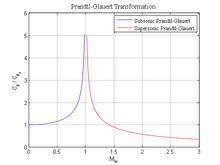Prandtl–Glauert singularity
.jpg)
The Prandtl–Glauert singularity is the prediction by the Prandtl–Glauert transformation that infinite pressures would be experienced by an aircraft as it approaches the speed of sound. Because it is invalid to apply the transformation at these speeds, the predicted singularity does not emerge. This is related to the early 20th century misconception of the impenetrability of the sound barrier.
Reasons of invalidity around Mach 1
The Prandtl–Glauert transformation assumes linearity (i.e. a small change will have a small effect that is proportional to its size). This assumption becomes inaccurate at high Mach numbers and is entirely invalid in places where the flow reaches supersonic speeds, since sonic shock waves are instantaneous (and thus very non-linear) changes in the flow. Indeed, one assumption in the Prandtl–Glauert transformation is approximately constant Mach number throughout the flow, and the increasing slope in the transformation indicates that very small changes will have a very strong effect at higher Mach numbers, thus violating the assumption, which breaks down entirely at the speed of sound.
This means that the singularity featured by the transformation near the sonic speed (M=1) is not within the area of validity. The aerodynamic forces are calculated to approach infinity at the so-called Prandtl–Glauert singularity; in reality, the aerodynamic and thermodynamic perturbations do get amplified strongly near the sonic speed, but they remain finite and a singularity does not occur. The Prandtl–Glauert transformation is a linearized approximation of compressible, inviscid potential flow. As the flow approaches sonic speed, the nonlinear phenomena dominate within the flow, which this transformation completely ignores for the sake of simplicity.
Prandtl–Glauert transformation

The Prandtl–Glauert transformation is found by linearizing the potential equations associated with compressible, inviscid flow. For two-dimensional flow, the linearized pressures in such a flow are equal to those found from incompressible flow theory multiplied by a correction factor. This correction factor is given below:[1]
where
- cp is the compressible pressure coefficient
- cp0 is the incompressible pressure coefficient
- M∞ is the freestream Mach number.
This formula is known as "Prandtl's rule", and works well up to low-transonic Mach numbers (M < ~0.7). However, note the limit:
This obviously nonphysical result (of an infinite pressure) is known as the Prandtl–Glauert singularity.
Reason for condensation clouds
The reason for the condensation cloud that is being observed is that humid air is entering a low-pressure region, which also reduces local density and temperature sufficiently to cause condensation. The vapour vanishes as soon as the pressure increases again to ambient levels. In the case of objects at transonic speeds, the pressure increase happens at the shock wave location. Condensation in free flows does not require supersonic flow. Given that the humidity is high enough, it can happen in purely subsonic flow over a wing or in the cores of wing tip and other vortices. This can often be observed on humid days on aircraft approaching an airport.[2]
See also
References
- ↑ Erich Truckenbrodt: Fluidmechanik Band 2, 4. Auflage, Springer Verlag, 1996, p. 178-179
- ↑ http://www.airliners.net/photo/Cargolux/Boeing-747-8R7F-SCD/2450886/&sid=674c6ac9a0c1c3d0146fa6fc632c5377